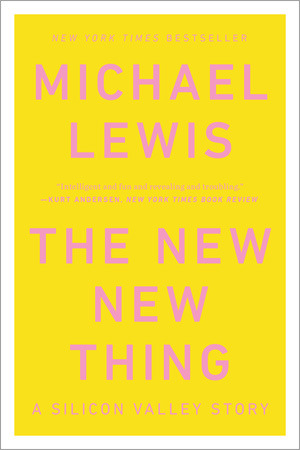The New New Thing Review
Review

Disclaimer: Amazon Affiliate Link
If you have been following my reviews of Michael Lewis’ books so far, you will notice that none of them have been his novels that have been turned into Hollywood blockbusters. The New New Thing is his first book where he steps outside of finance and his first foray into focusing on a character larger than life - James Clark - the serial entrepreneur that pioneered how Silicon Valley raises money. I personally believe this book is where Lewis hones his story telling abilities by spending months following and living with James and the secondary characters. By putting in this effort and time interviewing the characters, he is able to write a non-fictional story as if he created the characters himself. More grotesquely, he writes from the point of view of characters as if he had Texas Chainsaw Massacred not only their skin, but also their minds.
While the book is inherently a biographical account of the events of Silicon Valley during the Dotcom era, Lewis refrains from straying too far into the technological material (probably because he is a self-described techno-idiot) and keeps the story interesting by piggy-backing off of James Clark’s eccentricities. For those that don’t know, James Clark founded 3 separate companies that each went on to make him successfully more and more money. He was also an avid sailor and built the largest sailboat in the world while he was founding these companies. To make matters even more interesting, he wanted his boat fully automated. Remember, we’re talking the late 80’s/early 90’s here when only a few select individuals could afford good computational resources. The book basically recounts how Clark built these companies while having a over-arching subplot of this sailboat being built and whether or not it will make its native voyage across the Atlantic. Oh, I forgot to mention he was a high school dropout, went into the Navy (sailor remember?), got his Bachelors at night time (with no high school diploma - what?), and finally got his PhD at the age of 30. Then, he went to Silicon Valley to leave his legacy… wow.
For me, this book was also incredibly nostalgic of when I lived in San Jose in 2014/15 as I could actually picture the places that were being described. As a techy, reading about the development of Silicon Valley and one of its pioneers was more like a rite of passage and a journey to Mecca. So if you are into computers and entrepreneurship, this is a definite read. Or if you want to read about someone who shaped Silicon Valley as drastically as Steve Jobs but no one has heard of, this is the book. Or, if you just want to read how crazy James Clark was - think Howard Hughes meets Bill Gates (reclusive, zany, geeky, and rich) - there are definitely many parts in this book for you.
If I haven’t sold you yet, let me tell you about the companies James Clark founded.
Silicon Graphics Inc. (SGI)
After a stint as a professor at Stanford in computer graphics, he decided to leave and start a company that made graphics computer chips in 1984. At the time, these allowed people to display 3D images with a reasonably priced computer. Effectively opening up the world to see things on screens that weren’t simply videos of real life or simple drawings. In particular, any “revolutionary” Hollywood movie in the early 90’s that you can think of probably used this technology. Yes, Jurassic Park, Men in Black, Toy Story, even Star Wars Episode I - The Phantom Menace. Ok, that last one had terrible graphics. But you get the point. Sadly, this was his greatest engineering achievement yet the company that made him the “least” amount of money. This was the impetus for his aggressive money raising for his subsequent ventures as he felt slighted that the people who made the most money were the ones that lent it to him in the beginning, not the guys who built the technology. He left in 1994 in dispute with management.
Netscape
Have you heard of Netscape? Clark recruited Marc Andreessen (yes, the guy who now is the go to venture capitalist in Silicon Valley) out of undergrad because he developed a program that made navigating the Internet easy at the time. This turned into Clark’s next venture, Netscape. Using the money he made from SGI, Clark basically self-financed the start of the company with $4 million in 1994 and heavily pushed for an IPO the following year. Getting in on the Dotcom bubble at precisely the right time and even more fortunately out at the right time in 1999 turned his $4 million into $1.2 billion. That’s not bad for 5 years of work. Except, this time he wasn’t really an engineer doing hardcore technical work like at SGI, but rather more the visionary and leading a team of other engineers. As one of his top engineers at SGI describes it
Watching the B team of computer science whooping it up down the road after the Netscape public offering enraged him
That is, Clark didn’t even have his best engineers, just the ones that were willing to leave and his ragtag team of undergrads with no real life experience. This no doubt was the start of Silicon Valley’s culture of risk taking startups and “faking it till you make it” mentality that was non existent before Clark step foot in Santa Clara Valley.
Healtheon
Now I know what you are thinking, “I’ve never heard of Healtheon”. That’s because it was bought out by WebMD. Yes, the website that tells you that your symptoms lead to a rare form of cancer based on a couple of symptoms. I jest, but these two companies were supposed to be the next big thing in health care. They were supposed to essentially become the American health care system. That was the level of hype during the Dotcom era. Clark basically founded Healtheon with nothing other than a triangle on a piece of paper in 1995 and again aggressively pushed an IPO. This time, it took 4 years for the IPO to happen, but the stock went bonkers and shot up on the first day of trading and rose meteorically. Lucky for Clark, Microsoft wanted to get into the health care space and bought a startup called WebMD. Clark, not wanting to battle Microsoft and their monopoly, merged Healtheon with WebMD with what involved a deal of $100’s million going Healtheon’s way. Not bad considering it took WebMD up until last year to sell for $2.8 billion.
Somehow, this book contains about 5 stories: the life of James Clark, his 3 companies, and his crazy boat which Lewis ties together masterfully. A technophile’s delight.
If you want to buy this book and support my site, here is my Amazon affiliate link: The New New Thing: A Silicon Valley Story
Next Up: Next by Michael Lewis
Cheers,
Zach

